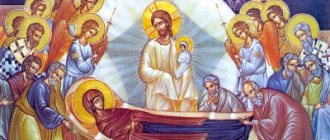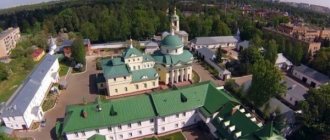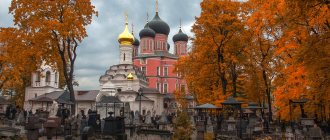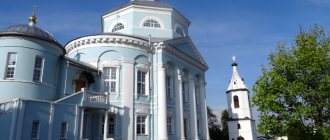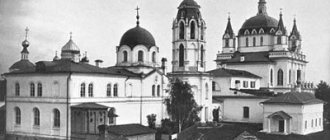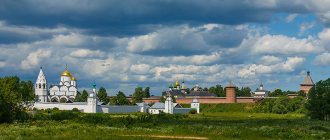The St. Danilov Monastery, or, as it is also called, Danilov or Danilovsky Monastery, was built at the end of the thirteenth century by Prince Daniil of Moscow. This monastery was attacked more than once and was almost completely destroyed. However, each time it was restored again.
The last time the monastery was closed was in 1918, after which an NKVD detention center was located there.
In 1982 L.I. Brezhnev decided to sign a decree on the restoration of the monastery and its return to the Russian Orthodox Church. And after that the monastery did not stop its work, being still active.
Danilovsky Monastery in Moscow. Shrines
The most important shrine of the monastery is the miraculous relics of Prince Daniel, its founder.
It was thanks to them that the restoration of the monastery began during the reign of Ivan the Terrible. After the transfer of the monks to the Spassky Monastery, only a small church and a cemetery remained in Danilovsky. However, at the grave of Prince Daniel, various kinds of miracles and healings of the sick began to occur. Most likely, this is what served as the impetus for the restoration of the monastery. The prince was canonized in the 17th century. It was then that his relics were discovered. After 1930, they were kept in the Church of the Resurrection of the Word, located near the Danilovsky Monastery. Then they disappeared without a trace. In 1986, the Metropolitan of Washington donated the first particle of the relics to the monastery. Today, several parts are stored here, placed in icons, a shrine and an ark. The Icon of the Matrona of Moscow is another shrine located at the Danilovsky Monastery in Moscow. During her lifetime, Matrona was a deeply religious person. She was born completely blind. There was a bony bulge in the shape of a cross on her body. From the age of seven she discovered the gift of healing the sick. She died on May 2, 1952. For a long time, her grave at the Danilovsky cemetery was desolate. Later, miraculous healings began to occur here. The relics of the saint were discovered in 1998. Nowadays they are kept in the Intercession Convent.
The Danilovsky Monastery in Moscow is the owner of other shrines. The most interesting are:
- Ark with the relics of St. Nicholas the Wonderworker.
- Ark with the relics of Alexander Nevsky.
- Shoe of Spiridon of Trimifuntsky.
- Icon of Sergei of Radonezh.
- Icon of Seraphim of Sarov.
PETROVSKY BELL
St. Daniel's Monastery in Moscow
The Petrovsky Bell has an interesting fate: in 1812, during Napoleon's invasion, the monastery was plundered and desecrated by the filthy European civilizers.
Before fleeing Moscow, the French tried to blow up the Transfiguration Cathedral, but, as always, something went wrong with the scum, the explosive mechanism, by God's permission, did not work.
The only thing the European enlighteners could do was to set fire to the monastery, having previously looted the graves. During the fire, the wooden ceilings of the belfry of the bell tower above the Church of Saint Sava, founded by Patriarch Philaret, caught fire.
History of the Novospassky Monastery in Moscow
And the bell donated by Peter fell, the wooden beams burned out and it fell from the first tier, broke the vault, but was not injured. When the bell tower completely burst into flames, a smaller bell fell from above and broke the bell of Peter I.
For the 400th anniversary of the House of Romanov, a similar bell was cast for the Savior on Novy, weighing only a hundred pounds less. Parishioners collected funds for the casting of the giant, made it at the Tutaevsky bell foundry in the Yaroslavl region, and it was named Romanovsky.
Now it is under the bell tower and is waiting in the wings to take its rightful place on the bell tower, which was built by the Russian architect Ivan Grebtsov during the reign of Empress Elizabeth Petrovna and Catherine II, the bell tower is only a meter lower than the bell tower of Ivan the Great.
Novospassky Monastery Princess Tarakanova
Princess Tarakanova
Empress Elizabeth favored the monastery and often visited it, and here the remains of Princess Tarakanova, who was the daughter of Elizabeth Petrovna with Count Alexei Razumovsky, were found to rest.
She was tonsured a nun under the name Dosithea by the will of Empress Catherine II, who did not want to take upon herself the murder of an innocent princess.
Elder Dosithea spent 25 years in the St. John the Baptist Monastery; she died in 1810. At her funeral service, the entire Moscow nobility, led by the Governor-General, arrived.
Temple of Roman the Sweet Singer in Moscow
Her burial took place precisely on the territory of the Novospassky Monastery in the tomb of the Romanovs by direct order of the Emperor, this directly indicates her origin.
A century later, in 1907, a chapel was built over the burial site. at the end of the 20th century, the ashes of the nun Dosithea were reburied in the Church of St. Roman the Sweet Singer.
Governor General, Grand Duke Sergei Alexandrovich Romanov, son of the Tsar the Liberator
The last burial of the Romanov tomb was the ashes of Grand Duke Sergei Alexandrovich, son of the Emperor Liberator Alexander II and uncle of Emperor Nicholas II. He was the Moscow Governor-General and died from a bomb thrown by the terrorist Kalyaev.
At first, his remains were buried in the Chudov Monastery, after the Revolution the Chudov Monastery was destroyed, and finally, 90 years after his death, his remains found peace in the tomb of the Romanovs.
Tomb of the Romanovs in the Novospassky Monastery
The personal belongings of Sergei Alexandrovich stored in the museum of the Novospassky Monastery silently but eloquently tell about what happened after the explosion. The museum contains the Grand Duke's boots and carriage upholstery.
His coffin was opened by the Bolsheviks, greedy for other people's money and looking for treasure. At the grave of Sergei Alexandrovich there are always fresh flowers and a lamp burning. Especially many people come on February 17, it was on this day in 1905 that he was killed.
In memory of the Grand Duke, a worship cross was erected on the territory of the monastery. An exact copy of the monument, created according to the design of the artist Viktor Vasnetsov in 1908.
Elizaveta Feodorovna, the widow of the Grand Duke, forgave Kalyaev, she petitioned for his pardon, but he refused to sign the petition and was hanged.
Murderer Kalyaev
The Bolsheviks who came to power immediately rushed to desecrate and rob graves and destroy crosses. Vasnetsov’s cross-monument was the first to be destroyed; Ulyanov-Lenin participated in its destruction, who personally signed a decree on the demolition of crosses on the graves of the Romanovs.
Nicholas ll in the Novospassky Monastery
Without exception, all All-Russian Sovereigns, starting with Mikhail Fedorovich, made ceremonial royal exits to the monastery to the graves of their ancestors.
What is an example for us of how we treat our deceased ancestors, every day of remembrance of the departed they came to the monastery and performed a memorial service.
In the year of the 300th anniversary of the Romanov dynasty, Emperor Nicholas II visited the monastery; on May 26, 1913, the sovereign deigned to thank the monastery’s folk choir for the harmonious and beautiful singing.
Novospassky stauropegial monastery, Moscow
Service of St. Daniil
Sretensky Monastery in Moscow: opening hours, schedule of services, address and photo
The first service to St. Daniel was composed by Archimandrite Constantine (rector of the monastery) in 1761. However, forty years later, the life of the prince and a new service were compiled by Metropolitan Platon (Levshin). Now every Sunday an akathist was read before the holy relics of Daniel. And on memorial days, a religious procession was sent from the Kremlin cathedrals to the Zamoskvorechye Monastery of St. Danilov. Over time, a chapel in honor of St. Daniel of Moscow was consecrated in the monastery church. His tomb was moved to the left choir and a silver frame was made for it with the donation of Fyodor Golitsyn. In 1812 it was stolen by Napoleonic troops. Therefore, in 1817, the relics of St. Daniel of Moscow were placed in a new silver shrine. Nearby, on the wall, was placed a full-length icon of the prince, painted on the former wooden lid of his tomb.
Schedule of services (on weekends, weekdays, holidays)
Table:
| Day of the week | Divine service | Start time | Location |
| Weekdays | Midnight Office | 6 hours | Church of the Holy Fathers |
| Liturgy | 7 hours | ||
| Blessing of water prayer to Saint Daniel of Moscow | 9.30 | ||
| Evening service | 17:00 | ||
| Saturday and Sunday | Liturgy | 6.45 8.45 | Church of the Holy Fathers Trinity Cathedral |
| All-night vigil | 17:00 |
Confession takes place daily from 7 a.m., and on the eve of great holidays - at the evening service from 5 p.m. Every week on Sunday evenings an akathist to Saint Daniel is served, but every first Sunday of the month it is replaced by a prayer service to the Venerable Confessor George Danilovsky.
On Friday evenings in the Trinity Cathedral, the Mother of God prayer service for the Intercession and in front of the “Three-Handed” icon are held alternately.
In the Seraphim Church, every Tuesday and Friday from 10 o’clock the akathist to the Mother of God “The Tsarina of All” is served.
On the first days of Lent, during Holy Week and on Bright Week after Easter, custom prayers are not performed. At the rest of the time, at the request of believers, commemorations for health and dormition, a custom prayer service, or a private memorial service can be served. In the church shop or through the monastery website you can order requests for long-term commemoration.
But infant baptisms, funeral services and weddings are not performed here. You should definitely attend the festive service at the St. Danilovsky Monastery, because the most beautiful services are held here with the participation of one of the best choirs in Moscow.
Article design: Oleg Lozinsky
Used materials
- Spaso-Andronikov Monastery in Moscow: opening hours, schedule of services, address and photo
Article about the monastery on the official website of the Moscow Patriarchate:
- Palamarchuk Peter, “Sretensky stauropegial non-coenobitic monastery”:
- Page People's catalog of Orthodox architecture
:
- Website page Russian Orthodoxy
:
- Stroev P.M., Lists of hierarchs and abbots of monasteries of the Russian Church
. - St. Petersburg, 1877. p. 212 - 213.
Researchers name different years of foundation: , , .
Stroev’s last name is Ivanov, but the correct one is Uvarov, See Martynov A.A. Moscow bells // Russian archive. 1896, No. 2, p. 555-556,
John (Ludishchev), hierome, “Sretensky Monastery in 1759–1771”, portal Pravoslavie.Ru
, January 22, 2010,
Alla I. Osipova, “Archimandrite Victor (Savrasov) – builder and abbot of the Moscow Sretensky Monastery (1853–1859, 1872–1880),” portal Pravoslavie.Ru
, January 30, 2014,
John (Ludishchev), hierome, “Archimandrite Seraphim (Epiphany) - rector of the Sretensky Monastery (1884–1890).” Part 1, portal Pravoslavie.Ru
, September 2, 2009,
John (Ludishchev), hierome, “Archimandrite Seraphim (Epiphany) - rector of the Sretensky Monastery (1884–1890).” Part 2, portal Pravoslavie.Ru
, September 3, 2009,
Osipova A.I., “Moscow Sretensky Monastery during the period of the abbot of Archimandrite Dimitri (Klyucharyov): 1891–1904,” portal Pravoslavie.Ru
, October 25, 2011,
John (Ludishchev), Hierom., “Archimandrite Sergius (Plaksin) - the last Abbot of Sretensky Monastery during the years of revolutionary turmoil,” portal Pravoslavie.Ru
, November 11, 2014,
Commemorative Silver Coin
On June 1, 2021, the Bank of Russia issued a commemorative silver coin with a face value of 25 rubles “Novospassky Monastery, Moscow” (weight of precious metal in purity - 155.5 g, alloy fineness - 925, catalog No. 5115-0132) of the series "Architectural Monuments Russia." On the coin there are images: below - the ensemble of the Novospassky Monastery in Moscow, at the top - engravings with a panorama of the monastery.
List of abbots and governors
- John I (1330-1346)
- Peter (1346—1353)
- John II (1353-1374)
- Michael (1375—1377)
- Simeon (1382—1382)
- Sergius I (Azakov) (1389—1389)
- Ignatius (1389-1404)
- Theodosius (1404-1404)
- Matthew (1404-1404)
- Hilarion (1406–1406)
- Savva (1410-1410)
- Tryphon (1453–1462)
- Vassian (Snout) (1466-1468)
- Herman (1474—1474)
- Elisha (1483-1488)
- Athanasius I (1496—1515)
- Savva (1526-1530)
- Theodosius (1539-1542)
- Niphon I (1543-1554)
- Nikephoros (1554-1558)
- Galaktion (1558-1565)
- Athanasius II (1564-1564)
- Anthony I (1565-1568)
- Vassian II (1569-1575)
- Job (1575-1581)
- Joachim (1581-1589)
- Sergius II (1589-1589)
- Sylvester (1589-1598)
- Zacchaeus (1598-1599)
- Sergius III (1599-1606)
- Euthymius I (1610-1613)
- Joseph I (1613–1619)
- Niphon II (1623-1623)
- Lawrence I (1627-1629)
- Mitrofan (1629—1629)
- Tikhon I (1630-1631)
- Joseph II (1631–1637)
- Lawrence II (1638-1638)
- Jonah (1639–1645)
- Nikon (Minich or Minov) (1646-1649)
- Nikon II (1649—1654)
- Pitirim (1654-1655)
- Sergius IV (1656—1656)
- Joseph III (1658–1663)
- Prokhor (1663-1664)
- Joseph IV (1664–1674)
- Niphon III (1674—1697)
- Macarius I (1674—1681)
- Gabriel I (1681-1684)
- Ignatius (1684-1692)
- Tikhon II (1692-1695)
- Triphyllius (1695-1697)
- Isaiah (1697 - July 23, 1699)
- Hilarion I (1699-1701)
- Hilarion (Vlastelinsky) (1701-1702)
- Joasaph II (1702-1710)
- Dositheus (1710-1711)
- Moses (1711-1714)
- Arseny (1715-1716)
- Sergius V (1716—1720)
- Hierotheus (1721-1728)
- Euthymius II (1728-1730)
- Theophilus (1730-1732)
- Hilarion II (1733-1735)
- Nikodim (Skrebnitsky) (February 1736—1738)
- Anthony (Ilyashevich) (1739-1748)
- Gabriel (Kremenetsky) (April 5, 1748-1749)
- Misail (Chirsky) (1749—1764)
- Cyril I (1758—1758)
- Simon (1764-1769)
- John III (1770-1778)
- Joasaph III (1779-1785)
- Pavel (Ponomarev) (January 14, 1786-1794)
- Methodius (Smirnov) (February 14, 1794-1795)
- Ambrose (Yakovlev-Orlin) (1795-1796)
- Anastasy (Bratanovsky-Romanenko) (1796—1797)
- Iakinf (Karpinsky) (1797-1798)
- Alexander (1798-1799)
- Varlaam (1799-1811)
- Sergius (Krylov-Platonov) (June 14, 1811-1812)
- Ambrose (Ornatsky) (1812-1816)
- Filaret (Drozdov) (March 1816—1819)
- Kirill (Bogoslovsky-Platonov) (1819-1824)
- Polycarp (1824-1834)
- Apollos (Alekseevsky) (February 19, 1837 - March 1851)
- Agapit I (1851-1852)
- Agapit II (Vvedensky) (1852—1877)
- Porfiry (Uspensky) (1878 - April 19, 1885) bishop. b. Chigirinsky
- Peter (Ekaterinovsky) (August 9, 1885 - May 27, 1889) bishop. b. Tomsk
- Nestor (Metaniev) (1889-1894)
- Anatoly (Stankevich) (January 29, 1894 - December 20, 1898) bishop. b. Kaluzhsky
- Kliment (Stoyanovsky) (1898-1906)
- Boris (Shipulin) (1906-1909)
- Macarius (Gnevushev) (1909-1914)
- Evfimy (Eliev) (1914-1918)
- Kirill (Sokolov) (late 1917-1920)
- Palladium (Dobronravov) (1919-1922)
- Peacock (Kroshechkin) (1920-1921)
- Evgeny (Kobranov) (1922—1922)
- Alexy (Frolov) (March 1991 - March 22, 2011)
- Savva (Mikheev) (March 22, 2011 - July 14, 2018)
- Ioann (Rudenko) (July 14, 2021 - February 26, 2019)
- Dionysius (Porubai) (from February 26, 2021)
Sights of the monastery
- Unfortunately, the turbulent 20th century left little of the historical buildings of the monastery. The five-domed Cathedral of the Presentation of the Vladimir Icon of the Mother of God has been preserved, especially valuable because unique frescoes of the early 17th century by Kostroma and Yaroslavl masters have miraculously survived within its walls. Both the cathedral itself and the frescoes are made in the strictly laconic manner of the Moscow-Yaroslavl style.
- The new temple of the Sretensky Monastery, named in honor of the Resurrection of Christ and the New Martyrs and Confessors of the Russian Church, was consecrated in May 2021. The height of the temple is about 60 meters, thanks to which it is clearly visible from different points of the city. The building is designed in the style of ancient Suzdal cathedrals and decorated with stone carvings. The interior of the temple is decorated with 47 icons and fresco paintings.
- But still, the main attraction of the Sretensky Monastery is not the architecture. The men's choir of the monastery, which today is the main choir of the Russian Orthodox Church, is famous throughout the world. Under the leadership of regent Nikon Zhila, the choir takes part in holiday services, and also actively tours throughout Russia and abroad, performing sacred and folk music, as well as songs of the war years.
How to get to the Donskoy Monastery
You can get to the monastery either by public or by private transport or by taxi.
To the Donskoy Monastery by metro
The nearest station to the monastery is “Shabolovskaya”, from there it is about 1.5 km to the attraction. Coming out of the metro, you need to turn left and go to the tram stop, then you should turn right, moving along Shabolovka Street to the intersection with Pervy Donskoy Proezd. Next you need to turn right and go straight, the monastery will be visible on the left side, you need to walk along its wall to the gate located on the side of Donskaya Square.
You can walk to the monastery both from the Leninsky Prospekt metro station and from the MCC station Gagarin Square. After leaving the station, you need to go right to Vavilova Street and turn left, you should follow it until it turns into Ordzhonikidze Street. Then you need to turn left onto Donskaya Street and, moving along the wall of the monastery, reach the main gate.
Moscow metro map
How to get there
The Family Suitcase company organizes pilgrimage trips.
Travel from Yoshkar-Ola
Travel from Cheboksary
Travel from Kazan
The monastery was built on the right bank of the Moscow River. It is approximately 4.5 km from the Moscow Kremlin. The monastery complex was built on Danilovsky Val. Convenient to travel by metro. The exit stop is Tulskaya station. Also near the monastery there are trams number 35, 38, 3. You can use minibus number 3.
Brief history
The first historical records can only be seen in 1560. Thanks to Tsar Ivan IV the Terrible, monastic life began to revive. A year later, a beautiful monastery church was erected on the site of the cemetery. When the troops of the Crimean Khan Kazy-Girey began to approach the city’s borders as close as possible, a military camp appeared. It was here that the capital's armed forces were located.
The next stage came the Time of Troubles. Tsar Vasily Shuisky organized a battlefield near the monastery. Ivan Bolotnikov and Philip Pashkov acted as military leaders from the ranks.
St. Danilov Monastery has always been notable for being not crowded. By the 18th century, about 30 monks lived in the territory. The number of monks did not exceed 17. According to historical data, the monastery owned 178 acres, a stone courtyard and several houses.
The monks were engaged in charity. They provided assistance to the sick and infirm. In 1805, an almshouse began operating here. Elderly women lived there. After 50 years, a shelter appeared here. Elderly priests lived there.
In 1918, official power came and the monastery was closed. However, monastic life continued to exist. Bishops and bishops lived here, fleeing arrests. The year 1929 was a time of turning point changes. They issued a decree to liquidate the monastery. All the monks were driven out into the street, and the bell tower was destroyed. The bells did not have time to be melted down. This was facilitated by the American businessman Charles Richard Crane. The valuable element was kept for a long time at Harvard University. He returned to his homeland only in 2007.
In the 1930s, a process began aimed at eliminating the monastery cemetery. The ashes of famous personalities were transferred to the Novodevichy necropolis. These include writer N.V. Gogol, poet N.M. Yazykov, historian D.A. Valuev and others. The remains of the artist V.G. Petrov was buried on the territory of the Don Monastery. The rest of the burials met a merciless fate.
A reception center was set up in the liberated territory. The children of the repressed, who were called “enemies of the people,” lived here. Conditions were characterized by low levels. For this reason, children often suffered from various diseases. Those who could not cope with the illness were buried directly under the monastery walls. Since 1988, today a chapel for memorial services has been installed on the site of the monastery cemetery.
The territory was returned to the monastery only in 1983. In its place they created the residence of the Moscow Patriarch. Funds for restoration were created thanks to the efforts of Moscow parishes. Restoration efforts lasted for several years.
Modern view of St. Daniel's shrine
The temple ensemble of the Holy Fathers of the Seven Ecumenical Councils consists of several churches; the first floor is occupied by the Cathedral of the Intercession of the Most Pure Mother of God.
Trinity Cathedral of Danilov Monastery
The Trinity Cathedral, which houses the relics of St. Daniel of Moscow, remains the largest church of the monastery.
On a note! Believers come to the Trinity Cathedral to pray and ask for intercession from the miraculous icons of the Mother of God “Three-Handed” and St. John Cassian.
The modern architectural monastery ensemble contains newly built churches:
- Prince Vladimir the Great of Kyiv;
- Life-Giving Trinity;
- All Saints;
- Seraphim of Sarov;
- gate church of St. Simeon the Stylite;
- Church of the Nativity of John the Baptist;
- funeral chapel;
- overhead chapel.
Particles of the relics of St. Daniel remain the main shrine of the Danilovsky Monastery. They were returned in 1986 by the Archbishop of Washington.
Advice! There is a belief that if, when visiting the Danilov Monastery, you pray at the icon of St. Spyridon and put a note between your shoe and the holy face, then the answer to your request will definitely come.
Buildings and monastery attractions
The oldest surviving church, the Church of the Holy Fathers of the Seven Ecumenical Councils, appeared in the monastery in the 17th century. During the restoration of the monastery, it was thoroughly restored and re-consecrated.
The ancient temple is a complex architectural structure, the basement of which is the Church of the Intercession, built in the 60-70s of the 17th century. It is completed by two upper churches, which were erected in the first half of the 18th century.
The church in honor of Simeon the Stylite is located above the Holy Gate of the monastery. Above it, a slender bell tower rises 45 m.
The largest Cathedral of the Life-Giving Trinity can accommodate up to 3,000 believers. It was built according to the design of the famous architect Osip Bove in the 30s of the 19th century. The majestic building was erected in the Russian Empire traditions and decorated with elegant Tuscan porticoes.
Nadkladeznaya Chapel
In the west of the monastery territory there is a two-story building that houses the Patriarchal and Synodal residence. On its top floor there is a small house church of All Saints.
The monastery has preserved three stone buildings from the 19th century - the monastic building, the abbot’s chambers and the former hospital. On the square, in the middle of the monastery, you can see the Nadkladeznaya Chapel, erected in the year when believers celebrated the 1000th anniversary of the Baptism of Rus'. Visitors to the monastery also come to venerate the monument to Prince Vladimir and the khachkar stone donated by the abbots of the Armenian Apostolic Church.
Danilovsky Monastery in Moscow - history
The Danilovsky Monastery in Moscow was founded by Moscow Prince Daniil, the son of Grand Duke Alexander Nevsky. The prince was distinguished by piety, justice and mercy. He ruled for 30 years and during this time he managed to initiate the unification of the Russian lands around the future capital and became the first Moscow Grand Duke of All Rus'. Initially, a wooden church was built in the monastery in the name of St. Daniel the Stylite, patron of the holy prophet Daniel. Before his death, the prince took monastic vows. In 1303, he was buried, according to his will, in the simple brotherly cemetery of the monastery “not in the church, but in the fence.” The history of the Danilov Monastery is not simple. She had to endure many trials. In 1330, Daniil's son Ivan Kalita transferred it to the Kremlin, where it was safer from raids and assigned it to the Cathedral of the Savior on Bor. Then the monastery was moved to Krutitsky Hill. The Novospassky Monastery was built here. All this time, Danilov’s monastery remained desolate. It contained only a temple and a cemetery. The grave of Prince Daniel was abandoned. But the miraculous healings of parishioners visiting the grave of Prince Danil served to revive the monastery. Ivan the Terrible restored the ancient Danilovsky Monastery in Zamoskvorechye. The monastery was inhabited by monks. Previously subordinate to the Kremlin's Transfiguration Cathedral, it has now become independent again. And later, Prince Daniel was canonized and his incorruptible relics were found. Two days of remembrance of Saint Daniel were established - March 17, on the day of his death, and September 12, on the day of his discovery. relics (according to the old style this is March 4 and August 30).
The monastery was important in the defense of the capital. She played a big role in repelling the attack of the Crimean Khan Kazy-Girey in 1591
In troubled times, in 1606, rebels led by Bolotnikov were defeated by the army of Tsar Vasily Shuisky. In 1610, the impostor False Dmitry II set fire to the monastery. But soon it was rebuilt and surrounded by a beautiful stone wall with towers. In beauty it could be compared with the fortress wall of the Kremlin. During the war with Napoleon, the monastery was plundered. A silver frame, created with a donation from Prince Fyodor Golitsyn, was stolen from the tomb of Saint Prince Daniel. In 1817, the holy relics of Prince Daniel were placed in a new silver shrine. After the revolution, during the persecution of the church, the monastery was also subjected to persecution and repression. The 300-year-old chapel was demolished. The Danilovsky Monastery in Moscow sheltered many clergy expelled from other churches for remaining faithful to the traditions of Russian Orthodoxy. They were called "Danilovites". Many of them were sent into exile or imprisonment. In 1930, the Danilovsky Monastery in Moscow was closed, and some of the monks were shot. The relics of Saint Prince Daniel disappeared. Perhaps the believers themselves carried them away to save them from desecration. A monument to Lenin was erected on the territory. There was a children's colony and warehouses. The graves were opened. The remains of some famous figures were moved to other cemeteries. Danilovo cemetery was barbarically destroyed. In 1983, the monastery was returned to the Russian Orthodox Church. Its restoration begins, which was completed in time for the celebration of the 1000th anniversary of the Baptism of Rus' in 1988.
History of the monastery
As already mentioned, the building was founded in the 13th century. The founder was Daniil Moskovsky. During his lifetime, the prince was a peace-loving, humble and meek ruler. But he repeatedly took military action, repelling the attacks of Tatar raiders. During his fruitful life, he made a lot of efforts to unite the Moscow principality.
Before his death, the prince became a monk and was buried in his temple. Since the 1650s, the princely relics have been in the Danilov Monastery, and are there to this day. You can visit them in the Church of the Holy Fathers of the Seven Cathedrals, which is located on the territory of the monastery.
There was also the old Danilovskoye cemetery. Many famous people are buried there, in particular:
- philosopher, Slavophile A.S. Khomyakov;
- writer N.V. Gogol;
- painter V.G. Perov.
But with the advent of Soviet power, the necropolis was completely destroyed in the 40s of the twentieth century. Also at this time, the communists closed the abbey and organized a colony for young thieves and criminals on its territory. For almost half a century, the activities of the sanctuary were prohibited. In the 80s, Brezhnev signed a decree on the restoration of the Orthodox monastery.
It took the monastic brethren about 5 years to recover. In 1988, the churches of the Danilov Monastery became the center of the celebration of the 1000th anniversary of the Baptism of Rus'. Today it is one of the main spiritual centers of the Russian Federation.
The best article for you, go to: Savvino-Storozhevsky Monastery in Zvenigorod
A little history
13th century! How it was…
Having resolved the dispute between his two brothers peacefully, without military action, the grateful Moscow prince in 1282 founded a temple in honor of Daniel the Stylite, whom he revered as his heavenly and omnipotent patron.
According to an ancient legend, Prince Daniel later took monastic vows and bequeathed to be buried, of course, in the monastery he himself founded. Which was, of course, done.
And in 1652 his relics were found incorrupt. With worthy honors, in front of a huge crowd of people, by decree of Tsar Alexei Mikhailovich, they were moved to the Church of the Seven Ecumenical Councils, located here.
Nowadays, not far from the monastery, almost at the exit from the Tulskaya metro station, in a small park, there is a monument to the holy noble prince Daniil of Moscow. Its coordinates: 55.7129, 37.62305.
But let's return to the monastic history.
Oblivion and revival of the monastery
In 1330, Daniel's son transferred the inhabitants of the monastery to the Kremlin, to the princely court. Modern scholars suggest that he did this because he was seriously thinking about making Moscow the capital of the state. For as many as 300 years, a small wooden church and a small village with it were left without proper attention and care. Everything gradually deteriorated and fell into disrepair.
Only in 1650 the abandoned temple was revived by the decision of Tsar Ivan the Terrible. The times were turbulent, and the monastery was always in the center of devastating military events. And in 1812, before Napoleon’s troops entered Moscow, he was, one might say, evacuated. His holy relics and treasury were simply taken out of the city.
When the situation became more or less calm, everything returned to normal. The monastery began to live an ordinary life. Gradually it took on the form that exists to this day.
It is known that from the beginning of the 19th century it housed a shelter for elderly clergy and elderly women and their widows.
Pages of history. This was also
In 1918, the monastery ceased to exist, but only formally. In fact, life went on there. But this did not last long, and in 1929 global changes began. The new government ordered the bell tower of the Danilovsky Monastery to be dismantled and the bells sent for melting.
According to the documents, everything was done that way. But this did not happen in life. American diplomat Charles Crane miraculously managed to take them to Harvard University, where they remained until 2007. The first bell to be returned to its homeland was called “Everyday”.
Even the dead were uneasy at that time. The monastery cemetery that existed there was devastated and then completely destroyed. Particularly famous people: Gogol, Yazykov and some others were reburied at the Novodevichy cemetery.
In 1930, on the holy land of the monastery there was an isolation ward for children, so-called enemies of the people. Mostly these were children of people shot at the Butovo training ground by the NKVD. Alexy-2, the Patriarch of Moscow and All Rus', called this terrible training ground “Russian Golgotha.” More than 20,000 people were shot there.
And their children were collected in an orphanage on the territory of the Holy Trinity Danilov Monastery. Naturally, there could be no talk of any normal conditions. Children there got sick and died. A place with numerous children's remains was discovered near one of the monastery walls.
In memory of everyone buried on the lands of the St. Danilov Monastery throughout its history, a memorial chapel was erected here.
Since 1983, the monastery complex on Tula began to be revived. Now it bears the proud name “stauropygial”, that is, the Abbot of the Danilovsky Monastery is only the ruling bishop of Moscow himself (Patriarch of All Rus'). In addition, the Department for External Church Relations and the building where meetings of the Holy Synod are held are located on its territory.
In 2007, a white stone crypt was accidentally discovered under one of the galleries of the Church of the Holy Fathers of the Seven Ecumenical Councils. It is believed that Archbishop Nikephoros Theotokis, a Greek enlightener, was once buried there. Not far from this place there is now a memorial cross made of white marble.
In the basement of the hospital building, at the moment, there is a temple of Seraphim of Sarov. In the building of the Patriarch's residence there is a church in the name of All Saints who asked for the Russian land.
Schedule of services and conversations with the priest
They are held for a week in the Church of the Holy Fathers.
From Monday to Friday from 6.00. On Saturday from 6.45, and on Sunday from 6.30. Prayers, akafastas, and memorial services are also performed. Only in this church is confession performed during the Liturgy of the Presanctified Gifts. Every day in the reception room located in the fraternal building, there is an opportunity to receive information and talk with the priest. Business hours:
- weekdays starts from 9.00 to 17.00;
- On Sundays and major holidays, two Liturgies are held - from 12.00 to 17.00.
Official information, directions, reception schedule and a detailed schedule of services for the current week and other information can be found on the website of the Danilov Monastery.
Keep in mind: baptisms, weddings and funerals are not performed here.
Nowadays, this famous Moscow landmark is visited by a large number of people until late. It pleases the eye with its well-groomed buildings and high-quality restoration. There is perfect order everywhere here. These places are the spiritual and administrative center of Orthodox Moscow.
This is a unique example of excellent Russian culture, where people go to venerate the relics and perform prayers. Walking here is a pleasure. The atmosphere of this place is imbued with hospitality and cordiality.
For more information about the Moscow Danilovsky Monastery, watch the following interesting video:



